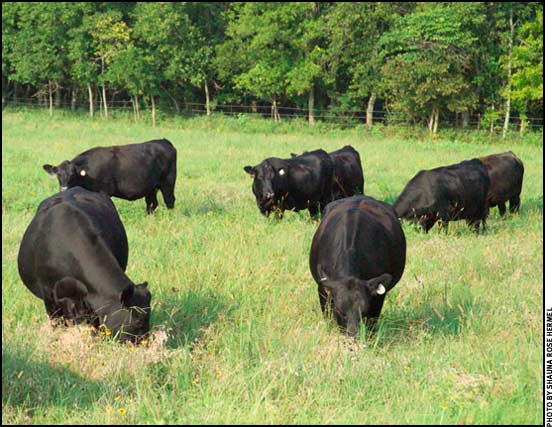HEALTH & NUTRITION...

Weigh 'em Up
Proper dosing helps contribute to producer profits.
The ability of producers to estimate the live bodyweight of cattle can critically affect whether animals receive too little drug or too much, which can have a significant effect on herd health and, ultimately, on the profitability of a producer's operation. Given that the weight of mature cows has increased by more than 300 pounds (lb.) during the past 30 years, the potential for under- or overdosing poses a real health and financial risk for any operation that estimates cattle weight.1
Proper dosing is especially important when it comes to parasite control, which is the most economically important practice in beef production.2 With inadequate or no parasite control programs in place, the cost to producers can be as much as $200 per head per grazing season.3 Producers simply can't take chances when it comes to properly administering parasite control products. Read more.
Proper Nutrition Vital for Livestock in Late Gestation
Cows late in gestation need higher crude protein and total digestible nutrients.
As livestock managers anticipate the beginning of the spring calving season, it's vital that they make sure their cows and heifers are getting the proper nutrition.
"We have some poor-quality hay out there this year, and that's not what you should be feeding cows in late gestation — or if you do, you need to supplement it," Rory Lewandowski, agricultural and natural resources educator for Ohio State University (OSU) Extension, said. Unusual weather in 2011 is the most likely cause of so much hay with lower-than-optimal crude protein (CP) and total digestible nutrient (TDN) values, but first cuttings often have lower-than-desired nutritional values, he said. Read more.
Oral or IV
When a scouring calf needs rehydration, should it be provided orally or intravenously?
When treating scours, producers often wonder whether the sick calf needs fluids and, if so, should it be given fluids orally or intravenously (by IV)? Steve Hendrick, University of Saskatchewan, says if the scouring calf is easy to catch, it needs fluid. Oral fluids, given often enough, can reverse dehydration unless the calf has gone past the point where it can absorb fluids through the gut.
Once the calf becomes too dehydrated, the gut shuts down and oral fluids can't be absorbed. A good rule of thumb, he says, is if the calf can still stand and walk, give it oral fluids. If it is too weak to get up, has a poor suckle reflex (no longer tries to suck your finger when you put it into its mouth) and can't raise its head, the calf needs an IV. Read more.

Rick Rasby
Ridin’ Herd
Just how much forage does a
beef cow consume each day?
It's almost March, and for cow-calf producers in the Northern Great Plains, the majority of the cows are calving or are about to start calving. Spring grass isn't that far away, but it seems like it really is a long time before spring turnout. Cow-calf producers during this time period are typically feeding harvested forages. A frequent question from producers is "How much will my cows eat on a daily basis?"
Producers want to meet the cow's nutrient requirement, but they sure don't want to overfeed expensive forages. With the dry conditions this summer and harvested forages at a premium, closely estimating the amount of feed needed to get through this part of the winter will be important to contain cost. In addition, cattle have a certain requirement for specific nutrients such as protein, energy, and minerals and vitamins. Read more.
Control Liver Flukes
Don't let liver flukes take a bite out of your bottom line.
In today's market, every competitive edge makes a difference to a producer's bottom line. That's why it is so important to control potentially harmful parasites in beef cattle and dairy heifers.
While all parasites pose a threat to profitability, liver fluke infestations have been identified as one of the top 10 beef quality issues.1 Although they were traditionally prevalent only in Gulf and Pacific Coast areas, liver flukes are now found in 26 states, largely due to the movement of both cattle and hay across state lines.2 Liver flukes are microscopic creatures present on vegetation, and are ingested by grazing cattle. Once ingested, the flukes can migrate from the intestine to the liver, potentially causing hemorrhage or blood loss.1 Read more.
Study Simulates Effects of FMD Outbreak in Mexico
A good surveillance system and raising a more resilient breed of cattle could lessen the blow of a potential FMD outbreak.
In a worst-case scenario simulation of a foot-and-mouth disease (FMD) outbreak in Mexico, researchers found that establishing a good surveillance system and raising a more resilient breed of cattle could lessen the blow to the Mexican cattle industry should an outbreak of FMD or other infectious disease occur. Read more.
Nutrition for the Workhorse
Too-rapid change in horse rations can cause colic.
Horses need more feed to replace energy loss brought about by harsher weather conditions as the temperature turns colder, and that means equine owners need to take steps to ensure colic does not become a problem.Equine owners must practice sound management in altering their animals' rations if problems with colic or founder are to be avoided, said Dave Freeman, Oklahoma State University (OSU) Cooperative Extension equine specialist. Read more.
Cattle Diseases: Common Conditions/Terms
Click here for a list of common conditions and terms related to beef cattle diseases, such as anaplasmosis, brucellosis, BVD, E. coli, IBR and others.
[Click here to go to the top of the page.]











